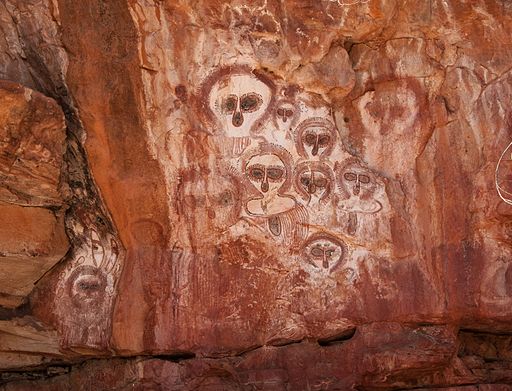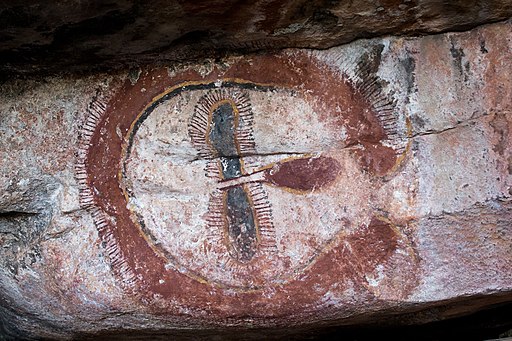
The Wandjina are cloud and rain spirits from Australian Aboriginal mythology that are depicted in rock art in Australia. The broad-stroke artwork dates to around 4,000 years ago.
The Wandjina paintings are characterized by common colors of black, red, and yellow on a white background. The spirits are depicted individually or in groups, vertically or horizontally, depending on the dimensions of the rock.
The large upper bodies and heads may show eyes and nose, but typically no mouth. They have no mouth because they are powerful and do not require speech, and if they had mouths, the rain would never cease.
The emergence of this art style follows the end of a millennium-long drought that gave way to a wetter climate characterized by regular monsoons.

Indigenous Australian rock art in the wandjina style, Kimberley, Western Australia
Around the heads of Wandjina are lines or blocks of color, depicting lighting coming out of transparent helmets. The spirits are sometimes illustrated with other figures and objects like the Rainbow Serpent or yams.
Today, the paintings are still believed to possess powers and therefore are to be approached and treated respectfully. Each site and its art has a name.
The indigenous people of the Mowanjum Community repaint the images to ensure the continuity of the Wandjina’s presence. Refreshing the paintings is a method of regenerating life force. Annual repainting in December or January also ensures the arrival of the monsoon rains, according to local beliefs.
Repainting has occurred so often that at one site, the paint is over 40 layers deep. The painting style has evolved during this process: more recent figures are stockier, and some now possess eyelashes.

Rock Painting of Wandjina from Mount Elizabeth, Australia.
Dreamtime
“Dreamtime” is a term devised by anthropologists to refer to a religious-cultural worldview attributed to Australian Aboriginal beliefs.
The Dreaming is used to represent Aboriginal concepts of “Everywhen” during which ancestral figures with supernatural abilities inhabited the land.
These figures were often distinct from gods as they did not control the material world and were not worshipped, but only revered. The Wandjina can punish those who break the law with floods, lightning, and cyclones.
Dreamtime stories tell how the Wandjina created the landscape and its inhabitants, and continue to influence both. When the spirits found the place they would die, they painted their images on cave walls and entered a nearby waterhole.
Creation is believed to be the work of culture heroes who traveled across a formless land, creating sacred sites and significant places of interest.
In this way, “songlines” were established, some of which could be used to travel right across Australia, through as many as six to ten different language groupings. The dreaming and traveling trails of the Spirit Beings are the songlines.
The concept of the Dreamtime has subsequently become widely adopted beyond its original Australian context and is now part of popular culture.

Aboriginal rock art in Wunnumurra Gorge, Barnett River, Kimberley, Western Australia.
Songline
A “Songline,” also called “Dreaming,” records the tracks across the land or sometimes the sky within the animist belief system of Aboriginal Australians.
The paths of the songlines are recorded in traditional song cycles, stories, dance, and art, and are often the basis of ceremonies. They are a vital part of Aboriginal culture, connecting people to their land.
Aboriginal Australians
The term “Aboriginal Australians” refers to the people who are members of the several hundred Indigenous peoples of Australia.
The category “Aboriginal Australia” was coined by the British after they began colonizing Australia in 1788.
The term was used to refer collectively to all the people they found already inhabiting the continent. It later also included the descendants of any of those people.
The Constitution of Australia, in its original form as of 1901, referred to Aboriginals twice, but without definition.
Before the British colonization of Australia, there existed several hundred groupings of Indigenous peoples of Australia with their own defined territory.
Within each region or country, people lived in clan groups: extended families defined by various forms of Australian Aboriginal kinship. Inter-clan contact was frequent, as was inter-country communication, but there were strict protocols around this contact.
The Australian Aboriginal languages, before colonization, consisting of over 300 languages belonging to an estimated twenty-eight language families.

Rock painting of Wandjina from Bachsten Camp, Kimberley Region, Western Australia.
Wandjina Depictions on Bark
Begining in the 1960’s several Mowanjum artists depicted traditional Wandjina on pieces of string bark. These artworks were sold mainly through the mission at Kalumbaru.
These artworks are now exhibited in significant museum collections around the world.
Bark painting is an Australian Aboriginal art form, involving painting on the interior of a strip of tree bark.
This practice is a form of artistic expression in Arnhem Land and other regions in the Top End of Australia.
Traditionally, bark paintings were produced for instructional and ceremonial purposes and were transient objects.
Today, they are keenly sought after by museums and public art institutions.
Indigenous Australian Rock Art – Wandjina Style
- Title: Indigenous Australian Rock Art – Wandjina Style
- Created: 4,000 years ago
- Materials: Ochre paints
- Museum: Kimberley region of Western Australia
Australian Aboriginal Sayings and Quotes
- Australian Aboriginal Sayings and Quotes
Virtual Tour of Aboriginal Artifacts and Stories
- Australian Aboriginal Rock Art – Bradshaw Rock Paintings
- Indigenous Australian Rock Art – Wandjina Style
- Australian Aboriginal Bark Paintings
- Coolamons and Aboriginal Carrying Vessels
- Aboriginal Shields
- Australian Aboriginal Shields
- Woureddy, an Aboriginal Chief of Van Diemen’s Land
- Trucaninny, wife of Woureddy
- Aboriginal Message Stick
- Platypus Nest
- Thylacine Skeleton (Tasmanian Tiger)
- Mummified Thylacine Head
- Aboriginal King Plate of Billie Hippie
- Australian Aboriginal Sayings and Quotes
- Bedgi-Bedgi
- Australian Native Police Uniform
- A Book of Drawings by Tommy McRae
- “View taken from the spot – Bateman’s Hill” by George Alexander Gilbert
Virtual Tour of Prehistoric Art and Artifacts
- Ain Sakhri Lovers
- Wolverine Pendant of Les Eyzies – Prehistoric Portable Art
- Antler Perforated Baton – Paleolithic Portable Art
- Venus of Brassempouy
- Head of a Cycladic Statue, Keros-Syros Culture
- Stargazer – Sculpture of a Female Figure
- Stargazer Figurine
- Dancing Girl (Mohenjo-Daro) from the Indus Valley Civilization
- Prehistoric Stone Hand Axe
- Great Handaxe from Furze Platt
- Clovis Weapons and Tools
- Neolithic Chinese Painted Pottery
- Korean Neolithic Pot
- Neolithic Pottery from Ban Chiang
- Li – Chinese Tripod Jar
- Comb-Pattern Pottery
- Phaistos Disc
- Sican Funerary Mask – Peru
- Greenstone Mask, Central America
- Australian Aboriginal Rock Art – Bradshaw Rock Paintings
- Indigenous Australian Rock Art – Wandjina Style
The Wandjina
The myth of Aboriginal Stories being Myths
Understanding Songlines: A 360 experience
Wandjina Tours
~~~
“Traveler, there are no paths. Paths are made by walking.”
– Ancient Aboriginal Saying
~~~
Photo Credit: 1)JRobyn Jay / CC BY-SA (creativecommons.org/licenses/by-sa/2.0); Claire Taylor from Everywhere, Australia / CC BY-SA (creativecommons.org/licenses/by-sa/2.0); Robyn Jay / CC BY-SA (creativecommons.org/licenses/by-sa/2.0); Graeme Churchard from Bristol (51.4414, -2.5242), UK / CC BY (creativecommons.org/licenses/by/2.0); Robyn Jay / CC BY-SA (creativecommons.org/licenses/by-sa/2.0)
Popular this Week








 Sponsor your Favorite Page
Sponsor your Favorite Page SEARCH Search for: Search Follow UsJoin – The JOM Membership Program
Sponsor a Masterpiece with YOUR NAME CHOICE for $5
Share this:
- Tweet
